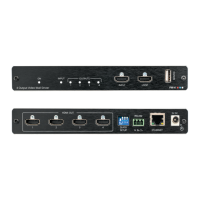
Do you have a question about the Kramer VW-4 and is the answer not in the manual?
| Product color | Black |
|---|---|
| Built-in display | No |
| RS-232/422 connector | Yes |
| HDMI input ports quantity | 1 |
| HDMI output ports quantity | 5 |
| Storage temperature (T-T) | -20 - 70 °C |
| Operating temperature (T-T) | 0 - 45 °C |
| Operating relative humidity (H-H) | 10 - 90 % |
| HDCP version | 2.2 |
| Maximum refresh rate | 60 Hz |
| Input voltage | 5 V |
| Power supply location | External |
| Depth | 195 mm |
|---|---|
| Width | 190 mm |
| Height | 27 mm |
| Weight | 900 g |
| Package depth | 212 mm |
| Package width | 351 mm |
| Package height | 72 mm |
| Package weight | 1400 g |
Guidance on unpacking, reviewing the manual, and checking for updates.
Recommendations for optimal video quality and system operation.
Important safety precautions for installation and operation.
Highlights key quality features of the VW-4 video-wall driver.
Details on advanced configuration and ease of use.
Lists common scenarios and environments where the VW-4 is ideal.
Explains how to control the VW-4 via DIP-switches, app, or serial commands.
Details and functions of the VW-4's connectors and indicators.
Specifies operating conditions and instructions for rack and surface mounting.
Illustrates connecting multiple VW-4 units for a video-wall configuration.
Details the pin connections for RS-232 communication between PC and VW-4.
Outlines Ethernet connection methods and PC network configuration steps.
Guide to using DIP-switches for basic video-wall setup.
Instructions for configuring video-walls using the VW-4 software application.
Steps for connecting VW-4 units to the network before using the app.
Lists actions performable via the VW-4 app, like device settings and layout.
Ensuring each VW-4 device has a unique IP address for network connectivity.
Process of selecting devices in 'All Units' and moving them to 'Selected Units'.
Steps to connect selected devices and verify connection status in the app.
How to change IP address and network parameters via app or P3K commands.
Procedure to assign unique ID numbers to each VW-4 device.
Instructions for updating the device firmware using the VW-4 app.
Detailed steps for saving firmware to memory stick and updating via app.
Restoring the VW-4 device to its default factory configuration.
How to access and view the network settings of the VW-4 device.
Managing EDID and HDCP settings for the device inputs.
Methods for uploading or selecting EDID files for input configuration.
Enabling or disabling HDCP for input signals and saving the settings.
Configuring how On-Screen-Display information is presented on outputs.
Setting HDCP status and saving per output configuration.
Setting the number of columns and rows for the video-wall configuration.
Manually defining video-wall dimensions using column and row selectors.
Using predefined options for common video-wall configurations.
Adjusting horizontal and vertical bezel corrections in pixels for display alignment.
Manipulating input image aspect ratio for non-square video-wall configurations.
Displaying the current DIP-switch configuration within the Layout tab.
Procedure for upgrading device firmware using the VW-4 application.
Specifications for HDMI, Ethernet, RS-232 ports and general connectivity.
Details on resolution, data rate, HDCP support, and video standards.
Specifications for DIP-switches, LEDs, software interfaces, and power requirements.
Details on operating conditions, safety compliance, and environmental ratings.
Information on regulatory certifications, enclosure type, dimensions, weight, and included items.
Default baud rate, data bits, IP address, subnet mask, and gateway.
Details on default monitor model, manufacturer, color characteristics, and EDID.
List of standard and CE video timings supported by the device.
Explanation of command and feedback formats, parameters, and chaining.
Detailed syntax for commands and feedback, including parameters and suffixes.
Reference for commands related to bezel, build date, EDID, and display status.
Reference for commands controlling DIP switches and Ethernet ports.
Reference for commands related to factory reset, HDCP mode, and HDCP status.
Reference for commands controlling audio mute, device naming, and DHCP settings.
Reference for commands managing gateway, IP address, and MAC address.
Reference for commands related to device reset, auto-sync, and OSD display.
Reference for commands checking signal status, firmware version, and video-wall layout.
List of error codes and their descriptions for protocol communication.
Details on what the limited warranty includes, excludes, duration, and limitations.